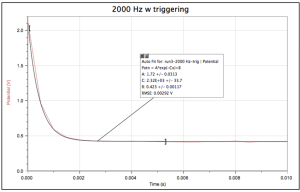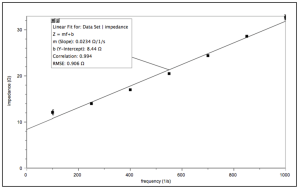Inductor User Manual
Order Code: IND
This air-core inductor is made from 24 gauge copper wire. It has an inductance of 5 mH and 2.4 Ω resistance. It is rated at 200 Watts. The included powdered-metal core can be added to increase inductance.
Note: This inductor was an accessory to the discontinued Vernier Circuit Board (order code VCB). The inductor is an included component on the Vernier Circuit Board 2 (order code VCB2).
Note: Vernier products are designed for educational use. Our products are not designed nor are they recommended for any industrial, medical, or commercial process such as life support, patient diagnosis, control of a manufacturing process, or industrial testing of any kind.
What's Included
- Inductor coil
- Powdered metal core
Suggested Experiments
This inductor can used in many physics experiments, including two in our Advanced Physics with Vernier – Beyond Mechanics book.
Experiment 13, “Capacitors and Inductors”, uses a simple DC voltage source and has students study how the potential across the inductor changes with time when you connect an RL circuit. A sample graph is shown below:

Experiment 14, “RLC Circuits”, studies RC, RL, and RLC circuits driven by a low‑voltage AC signal. In Part 2 of this experiment, the response of an inductor at various frequencies is studied. The impedance of the inductor (inductor in series with resistor) vs. frequency is plotted.

In Part 3 of the same experiment, an RLC circuit using an inductor, a 10 mF capacitor, and a small lamp acting as a resistor is used. Students drive this circuit at different frequencies and discover that the lamp lights up brightest at the resonant frequency.
The Powdered-Iron Core for the Inductor
The powdered-iron core that is included with the inductor can be inserted into the 0.520 inch hole in the inductor. It will increase the inductance considerably. The core is made of bits of metal in a non-conducting base to reduce eddy current losses.
You may want to have students experiment inserting a solid iron or steel object into the inductor and noting the change in both the inductance and the energy lost on eddy currents. For example, in the experiment with the light bulb and resonance described above, inserting a solid magnetic core inside the inductor will change the resonant frequency, but the energy losses will be large enough that the bulb will not light at the new resonant frequency.
Warranty
Warranty information for this product can be found on the Support tab at www.vernier.com/ind/#support
General warranty information can be found at www.vernier.com/warranty
Contact Support
Fill out our online support form or call us toll-free at 1-888-837-6437.

